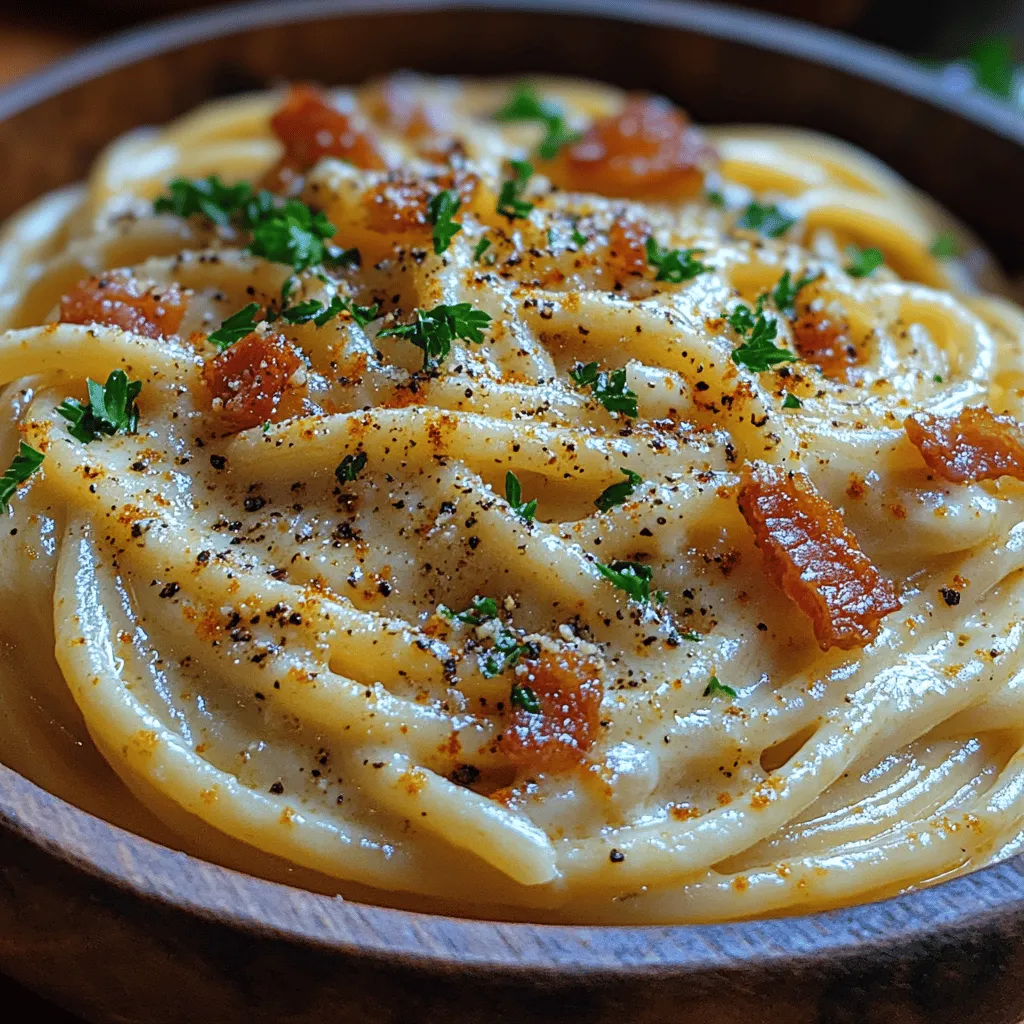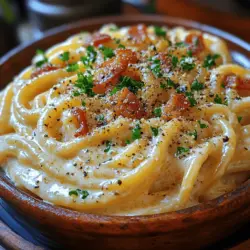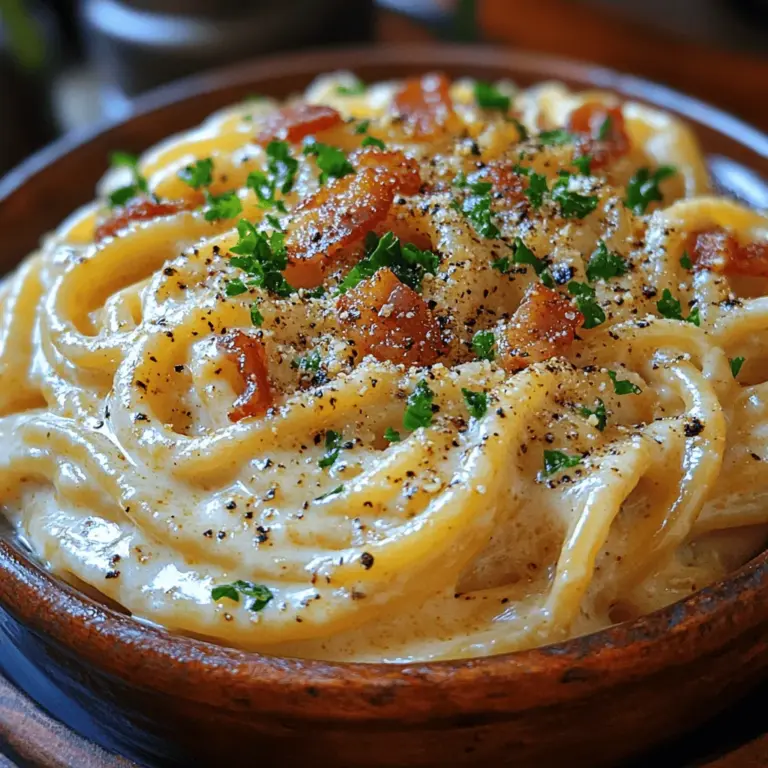Introduction
Creamy Bacon Spaghetti Carbonara is a dish that captures the essence of Italian cuisine, blending simplicity with rich flavors in every bite. This beloved classic has transcended its humble origins to become a favorite in kitchens around the globe. The combination of al dente spaghetti, savory bacon, and a creamy sauce made from eggs and cheese creates a satisfying meal that is both indulgent and comforting.
One of the key appeals of Carbonara lies in its beautiful balance of flavors. The salty, crispy bacon complements the creamy sauce, while the cheese adds a nutty depth that elevates the dish to new heights. What makes this dish particularly appealing is its straightforward ingredient list and quick preparation time. With just a handful of components, you can whip up a delightful dish that is perfect for weeknight dinners or special occasions alike. Whether you are a seasoned cook or a novice in the kitchen, preparing Creamy Bacon Spaghetti Carbonara is an accessible culinary adventure that promises to impress.
Understanding Carbonara: A Brief History
The origins of Carbonara trace back to the heart of Italy—Rome, where this dish first emerged in the mid-20th century. While its exact beginnings are shrouded in mystery, several theories attempt to explain how this creamy pasta dish came to be. One popular narrative suggests that Carbonara was created by Italian charcoal workers, known as “carbonai,” who would prepare their meals over an open fire and use easily transportable ingredients such as eggs, cheese, and bacon. This theory is reflected in the dish’s name, which is derived from “carbone,” meaning coal in Italian.
Traditionally, Carbonara is made with a few key ingredients: spaghetti, eggs, Pecorino Romano cheese, guanciale (cured pork cheek), and black pepper. While variations exist, including the use of thick-cut bacon, the essence of Carbonara remains intact. It is important to note that authentic Carbonara does not contain cream. Instead, the creamy texture is achieved through the emulsification of the eggs and cheese, resulting in a luscious sauce that clings to each strand of pasta.
The cultural significance of Carbonara in Italian dining cannot be understated. It is a dish that evokes a sense of home and comfort, often served during family gatherings or festive occasions. Each bite tells a story of tradition, craftsmanship, and the importance of quality ingredients. As you embark on your journey to create this iconic dish, understanding its roots will enhance your appreciation for the culinary artistry involved.
Ingredients Breakdown
Essential Ingredients
Spaghetti
When it comes to Carbonara, the choice of pasta is crucial. Spaghetti is the traditional pasta used for this dish, and its long, thin shape allows the sauce to coat each strand perfectly. The texture of spaghetti is ideal for holding onto the creamy sauce, making every bite a delightful experience. For the best results, opt for high-quality durum wheat spaghetti, which will provide an al dente bite and enhance the overall dish.
Thick-Cut Bacon
While traditional Carbonara calls for guanciale, thick-cut bacon is often used as a more accessible substitute, especially outside of Italy. Thick-cut bacon adds a satisfying crunch and a rich, smoky flavor that elevates the dish. Cooking the bacon until it is crispy not only enhances the flavor but also contributes texture to the creamy sauce. When selecting bacon, look for high-quality options that are free from artificial additives for a more authentic taste.
Eggs
In Carbonara, eggs play a pivotal role in creating the iconic creamy sauce. The yolks are what give the dish its rich texture and color, while the whites help to bind the ingredients together. When combined with the hot pasta, the eggs cook gently, forming a velvety sauce that clings to the spaghetti. Fresh, high-quality eggs are essential for achieving the best flavor and texture, so choose organic or farm-fresh eggs whenever possible.
Parmigiano-Reggiano Cheese
Parmigiano-Reggiano cheese is the preferred cheese for Carbonara, known for its complex flavor and granular texture. This cheese adds a nutty, savory note that complements the other ingredients beautifully. It is important to use freshly grated Parmigiano-Reggiano rather than pre-packaged options, as the latter often contain additives that can affect the flavor. The freshly grated cheese melts seamlessly into the sauce, creating a luscious coating for the pasta.
Garlic
While garlic is not traditionally included in authentic Carbonara recipes, it can be added to enhance the dish’s depth of flavor. A subtle infusion of garlic can provide a fragrant aroma and an additional layer of taste that pairs well with the bacon. When using garlic, be sure to sauté it gently with the bacon to avoid burning, which can impart a bitter taste.
Olive Oil
Olive oil is used to cook the bacon and garlic, adding richness to the dish. A good quality extra virgin olive oil not only enhances the flavor but also contributes to the overall healthfulness of the meal. The oil helps to render the fat from the bacon, creating a flavorful base for the sauce. Using olive oil in moderation ensures that the dish remains light and balanced.
Seasoning and Garnishes
Salt and Black Pepper
The seasoning in Carbonara is essential for enhancing the dish’s flavors. A pinch of salt is necessary to season the pasta water and balance the richness of the sauce. However, the real star here is freshly cracked black pepper. Carbonara is known for its generous use of black pepper, which adds a warm spiciness that cuts through the creaminess of the sauce. Be sure to use freshly ground black pepper for the best flavor.
Fresh Parsley
As a final touch, a sprinkle of fresh parsley adds color and brightness to the dish. The vibrant green of the parsley contrasts beautifully with the creamy sauce and crispy bacon, making the dish visually appealing. Additionally, parsley provides a fresh, herbal note that complements the rich flavors, enhancing the overall dining experience.
Step-by-Step Guide to Making Creamy Bacon Spaghetti Carbonara
Cooking the Spaghetti
To kick off your Carbonara adventure, start by bringing a large pot of salted water to a boil. The salt helps to flavor the pasta as it cooks, so don’t skip this step. Once the water is boiling, add the spaghetti and cook according to the package instructions, usually around 8-10 minutes, until the pasta is al dente. This means the pasta should be cooked through but still firm to the bite.
While the spaghetti is cooking, it’s a good idea to prepare your other ingredients. This will help streamline the cooking process and ensure everything is ready when the pasta is done. As the spaghetti cooks, you can focus on the next steps of the recipe, ensuring a seamless transition from pasta to sauce.
Once the spaghetti is cooked, reserve about a cup of the starchy pasta water before draining. This water is essential for creating the sauce, as it helps to emulsify the cheese and eggs, resulting in a silky texture. After draining the pasta, set it aside and get ready to complete your Creamy Bacon Spaghetti Carbonara.
With the spaghetti perfectly cooked and all your ingredients prepped, you’re well on your way to creating a dish that will delight your taste buds and impress anyone at your dinner table. Stay tuned as we dive deeper into the remaining steps of this delicious recipe!

Cooking Spaghetti to Perfection
To achieve the perfect al dente texture for your spaghetti, start by bringing a large pot of salted water to a rolling boil. Use about 1 tablespoon of salt per quart of water, as this is crucial for flavoring the pasta. Once the water is boiling, add the spaghetti and stir occasionally to prevent sticking. Cooking time varies depending on the brand and type of spaghetti; generally, it takes about 8-12 minutes. For al dente pasta, taste it a minute or two before the package instructions suggest. The spaghetti should be firm to the bite but not hard.
As the spaghetti cooks, remember to reserve about 1 cup of the starchy pasta water before draining. This water is a fantastic secret weapon for the sauce, as it helps to create a creamy consistency that clings beautifully to the pasta.
Preparing the Bacon
While the spaghetti cooks, it’s time to focus on the bacon. Start by cutting your bacon into small strips or lardons. For best results, use thick-cut bacon, which not only adds flavor but also provides a satisfying texture. Place the bacon strips in a cold skillet and turn the heat to medium. Cooking bacon gradually allows the fat to render out effectively, making it crispy without burning.
Stir the bacon occasionally, allowing it to cook evenly. This process should take around 8-10 minutes. Once the bacon is golden brown and crispy, use a slotted spoon to transfer it to a paper towel-lined plate to drain excess fat. However, leave about 2 tablespoons of the rendered fat in the skillet to infuse the dish with flavor.
Sautéing Garlic
Next, it’s time to sauté the garlic. Turn the heat to low and add minced garlic to the skillet with the reserved bacon fat. Sauté the garlic for about 1-2 minutes, stirring frequently. You want the garlic to become fragrant and lightly golden, not browned or burnt. Burnt garlic can impart a bitter taste to your dish, so keep an eye on it. The visual cue to look for is a light golden color and a fragrant aroma.
Combining Pasta and Bacon
Once the spaghetti is al dente and drained, it’s time to combine it with the bacon and garlic. With the skillet still on low heat, add the drained spaghetti to the skillet, tossing it gently to coat the pasta with the bacon fat, garlic, and crispy bacon. This step is crucial, as it allows the flavors to meld together beautifully. Use tongs or a pasta fork to ensure that every strand of spaghetti is evenly coated.
Creating the Carbonara Sauce
Now for the pièce de résistance: the carbonara sauce. In a mixing bowl, whisk together 3 large eggs and 1 cup of freshly grated Pecorino Romano cheese until combined. The mixture should be smooth and creamy. To ensure the eggs don’t scramble when added to the hot pasta, it’s important to create a gentle heat transfer.
Take the skillet off the heat and let it cool for just a minute, then pour the egg and cheese mixture over the spaghetti. Quickly toss the spaghetti to coat it with the sauce, adding in the reserved pasta water a little at a time until you reach your desired creaminess. The heat from the pasta will cook the eggs gently, creating a velvety sauce. If you notice any clumps, continue to toss until the sauce is smooth and well incorporated.
Finishing Touches
Once the carbonara sauce is perfectly mixed with the pasta, stir in the crispy bacon. Taste for seasoning, adding extra salt and cracked black pepper to taste. For an added touch of freshness, finely chop some fresh parsley and sprinkle it over the top. You can also add a bit more Pecorino Romano cheese for garnish, enhancing both the flavor and visual appeal of your dish.
Tips for Perfecting Your Carbonara
To avoid common pitfalls when making carbonara, keep these tips in mind:
– Watch the Temperature: Ensure the pasta is hot enough to cook the eggs but not so hot that they scramble. Removing the skillet from direct heat before adding the egg mixture is crucial.
– Don’t Skip the Pasta Water: The starchy pasta water not only helps to emulsify the sauce but also enhances the overall flavor and texture. Always reserve more than you think you’ll need.
– Experiment with Ingredients: While traditional carbonara uses bacon or guanciale, feel free to experiment with different proteins like pancetta or even sautéed vegetables for a unique twist.
Pairing Suggestions
Creamy Bacon Spaghetti Carbonara pairs wonderfully with a variety of accompaniments. For a refreshing contrast, serve it with a simple green salad dressed with olive oil and lemon juice. The acidity from the dressing helps to cut through the richness of the carbonara.
When it comes to wine, a crisp white wine, such as Pinot Grigio or Sauvignon Blanc, is an excellent choice. The bright acidity in these wines complements the creamy sauce beautifully, enhancing your overall dining experience.
Conclusion
Making Creamy Bacon Spaghetti Carbonara at home is a rewarding experience that showcases the beauty of simple ingredients combined to create a comforting dish. The richness of the sauce, combined with the savory flavors of crispy bacon and aromatic garlic, creates a meal that is both indulgent and satisfying. Whether you’re cooking for a special occasion or just a weeknight dinner, this classic Italian dish is sure to impress.
As you embark on your carbonara journey, don’t hesitate to experiment with flavors and ingredients, making the recipe your own. Share your culinary creations with friends and family, inviting them to enjoy the delightful experience of cooking and savoring this iconic dish. Embrace the joy of homemade comfort food and relish every bite of your creamy, delicious carbonara.

